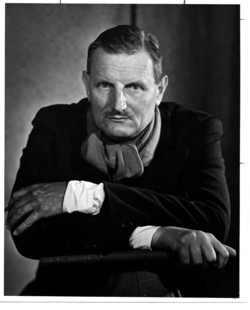Tyrone Guthrie facts for kids
Quick facts for kids
Sir Tyrone Guthrie
|
|
|---|---|
 |
|
| 4th Chancellor of the Queen's University Belfast | |
| In office 1963–1970 |
|
| Preceded by | 1st Viscount Alanbrooke |
| Succeeded by | Lord Ashby of Brandon |
| Personal details | |
| Born |
William Tyrone Guthrie
2 July 1900 Tunbridge Wells, Kent, England |
| Died | 15 May 1971 (aged 70) Newbliss, County Monaghan, Republic of Ireland |
| Spouse |
Judith Bretherton
(m. 1931) |
| Alma mater | Oxford University |
| Occupation | Theatrical director |
Sir William Tyrone Guthrie (born July 2, 1900 – died May 15, 1971) was a famous English theatre director. He helped start several important theatre groups. These include the Stratford Festival of Canada, the Guthrie Theater in Minneapolis, Minnesota, and the Tyrone Guthrie Centre in Ireland. He was known for his fresh and exciting ways of directing plays, especially those by William Shakespeare and modern writers.
Contents
Early Life and Education
Tyrone Guthrie was born in Tunbridge Wells, England. His family had a history in the arts. His great-grandfather was the Irish actor Tyrone Power. He was also a cousin of the famous film actor Tyrone Power.
Guthrie studied history at Oxford University. While there, he was very involved in student theatre. This early experience helped him decide what he wanted to do with his life.
A Career in Theatre
In 1924, Guthrie started working for the BBC. He produced plays for radio, which was a new and exciting medium at the time. He then directed plays for the stage with the Scottish National Players.
From 1929 to 1933, he directed plays at various theatres. His work in London at the Old Vic and the Sadler’s Wells theatres made him a well-known director. He was especially good at directing plays by William Shakespeare.
In the 1940s, Guthrie began directing operas. These are plays where the story is sung. He directed a very realistic version of Carmen at Sadler's Wells and the Metropolitan Opera in New York. He also helped bring back a famous medieval Scottish play called Ane Satyre of the Thrie Estaitis. For this play, he used a special stage design called a thrust stage. This stage sticks out into the audience, making the play feel more involving.
Stratford Festival of Canada
In 1952, Tyrone Guthrie was asked to help create the Stratford Festival of Canada. This was a new theatre dedicated to Shakespeare in a small Canadian town. He brought in talented people like designer Tanya Moiseiwitsch and actors Alec Guinness and Irene Worth.
The first plays were performed in a large tent. Guthrie was the Artistic Director for three seasons. His work there greatly influenced how theatre developed in Canada.
Guthrie Theater in Minneapolis
In 1963, Guthrie founded the Guthrie Theater in Minneapolis, Minnesota. He had put out an invitation in The New York Times asking communities if they wanted a new theatre. The Twin Cities area was chosen.
The theatre building was finished in 1963. Guthrie was the Artistic Director until 1966. He continued to direct plays there until 1969, just two years before he passed away.
Lasting Impact
Tyrone Guthrie was a very important figure in theatre. Many people saw him as one of the most important British theatre directors of his time. He helped create a new way of running theatres that received government support. He was also a brilliant director who inspired many others.
Guthrie wrote two important books about creating great theatre: Theatre Prospect (1932) and A Life in the Theatre (1959). His autobiography, A Life in the Theatre, was even turned into a stage play.
Queen's University Belfast
Sir Tyrone Guthrie was also the Chancellor of Queen's University Belfast from 1963 to 1970. This is a high-ranking position at a university.
Personal Life
In 1931, Tyrone Guthrie married Judith Bretherton. He was made a knight in 1961, which means he received the title "Sir." He died ten years later, in 1971, at his home in Ireland, at the age of 70. He was buried in the local churchyard.
See also
 In Spanish: Tyrone Guthrie para niños
In Spanish: Tyrone Guthrie para niños
- Guthrie Theater production history

